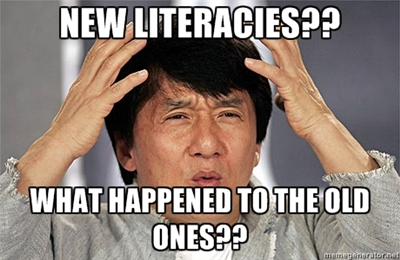How New Literacies are Relevant to Us
The recognition of new literacies has significant implications across several industries, especially in education. As a 4th-grade teacher, the impact these emerging literacies are having on my instructional practices is profound. After reading perspectives on digital literacy from ILA (2018) and Misha (2023), I was left with some unexpected takeaways that I will use to help mold and shape my craft as an educator who teaches literacy to the next generation. From the difference between digital fluency and digital literacy to strategies for implementation to perpetuating educational inequities, educators have a lot to dissect when investigating these new literacies.
Misha (2023) defines digital literacy as “the ability to navigate, consume, create and communicate online information appropriately in the digital world” and the word that immediately stands out is “appropriately.” Many students currently attending school have had access to iPads, Chromebooks, laptops, and other electronic devices in the classroom since the primary grades (K-2) and may have had access to devices even earlier at home. I am continually learning new things about digital tools from my students because they have built digital fluency rapidly in their early exposure to these digital tools. Despite this heightened knowledge of the digital world and how to navigate it, I would not say that they can use these tools “appropriately” and therefore do not have digital literacy. Students are unaware of the dangers that await them in the digital world and enter their personal information into insecure sites, download games/programs/software/etc. containing viruses, talking with people online they do not know, using digital platforms to bully others, and many other things that jeopardize their safety and well-being as well as the safety and well-being of others. It is the job of educators and parents to not only encourage this digital fluency but also promote appropriate usage of digital tools and guide them toward digital literacy.
To develop digital literacy in the classroom, teachers need to identify intentional strategies that will move students in the right direction. COVID abruptly threw teachers into the digital world and some high-leverage digital tools have emerged from this sudden need to teach remotely. Using these great new tools during our everyday instruction provides students with opportunities to develop and practice digital literacy skills and provides teachers with opportunities to teach students appropriate uses of digital tools. Teachers should find small ways to incorporate these digital tools into their current instructional practices and slowly work them into their day-to-day routines (Misha, 2023). By gradually incorporating these tools into their instructional practices, teachers can improve students' digital fluency while exploring the digital world with confidence.
The education system has systemic inequities that heavily impact historically marginalized groups, such as perpetuating unequal access to resources and opportunities based on race, class, and gender. The introduction of these new literacies can ultimately end up widening the achievement gap that it is intended to close (ILA, 2018). The problem lies with access to these new technologies. While one school may have abundant access, others may not have any access due to factors like funding. Because of this inequitable access to these emerging technologies, districts should instead focus on deepening teachers’ understanding of literacy and how to leverage materials of any kind to support students in reaching literacy learning outcomes rather than try to use expensive devices to put a Band-Aid over the problem (ILA, 2018). We must take an approach that prioritizes comprehensive literacy instruction to address these inequities.
It is imperative for us as educators to know and understand the difference between digital fluency and digital literacy, to implement strategies that promote safe and appropriate use of digital tools, and to be mindful of the systemic inequities that these resources can perpetuate. We can better support all students by developing comprehensive literacy instruction and using available materials in a meaningful way. This is just one more challenge that educators must face to create deliberate and equitable instruction that helps all students succeed in the digital world.
ILA. (2018). Improving digital practices for literacy, learning, and justice. International Literacy Association. https://www.literacyworldwide.org/docs/default-source/where-we-stand/ila-improving-digital-practices-literacy-learning-justice.pdf
Misha, A. (2023, March 29). Advancing Digital Literacy for a digitally inclusive future - edsurge news. EdSurge. https://www.edsurge.com/news/2023-03-29-advancing-digital-literacy-for-a-digitally-inclusive-future
St. Lucie County. (2015, October 25). Improve your digital awareness with a free Online Safety workshop at the Lakewood Park Branch on Friday, Nov. 1 at [Image attached] [Status update]. Facebook. https://www.facebook.com/StLucieGOV/photos/improve-your-digital-awareness-with-a-free-online-safety-workshop-at-the-lakewoo/1357538594423236/




Dear Allison.
ReplyDeleteI agree that “to develop digital literacy in the classroom, teachers need to identify intentional strategies that will move students in the right direction.” and indeed, this is another challenge educators have to face while creating curriculums and supporting students in succeeding in the digital world. Oftentimes teachers are overwhelmed with their workload, having to keep up with planning, instructions and assessments. This doesn't leave much time for developing digital literacy skills. Additionally, technology evolves so quickly, which makes it challenging to stay updated. That raises concerns about how to ensure that students become not just digitally fluent but also digitally literate.